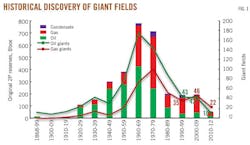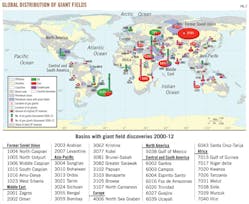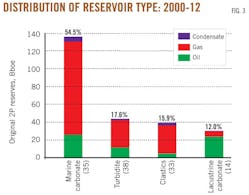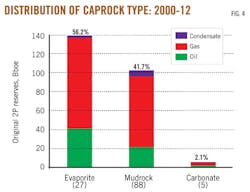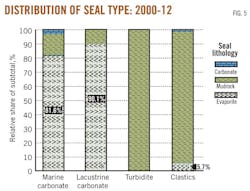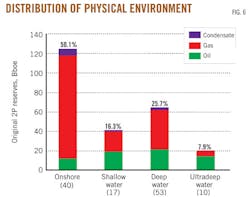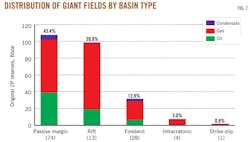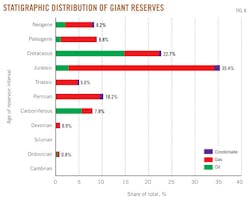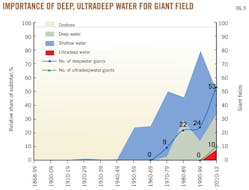Guoping Bai
Yan Xu
China University of Petroleum
Beijing
In spite of the increasing importance of shale gas and tight oil in the new century, future oil and gas supply continues to be dominated by conventional petroleum reserves. The International Energy Agency (IEA) has predicted that unconventional oil, which includes bitumen, heavy oil, and tight oil, will contribute only 13% of the global supply and unconventional gas consisting of tight gas, shale gas, and coalbed methane, 26% of the global gas supply by 2035.1
Conventional petroleum supply will come largely from the remaining reserves and reserve growth from both discovered and undiscovered giant fields. The importance of giant fields for future petroleum supply, particularly for regions other than North America, can never be underestimated.
This study attempts to document the geological features, distribution patterns, and discovery trends of giant fields—recoverable reserves of 500 MMboe or greater—discovered since 2000. Giant fields with unconventional petroleum (bitumen, extra-heavy oil, tight oil and shale gas) are excluded.
Rather than attempting an encyclopedic coverage of giant fields, we analyze general geological characteristics of 120 fields discovered 2000-12. Maps constructed on a global scale illustrate the regional distributions of giant fields.
At the same time, we focus more on the distribution of giant fields relative to known oil and gas producing basins along with original proved plus probable (2P) reserves by principal geographic region and basin type. On these bases, we discuss how future exploration will identify additional giant fields along several trends related to basin types, stratigraphic intervals, reservoir and trap types, and other indicators.
The reserves data presented here are from IHS Energy and our in-house global field database, developed through various projects funded by China Petroleum & Chemical Corp. (SinoPec), PetroChina Co. Ltd., China National Offshore Oil Corp. (CNOOC), and SinoChem Corp.
Global resource
The term "giant" is typically attributed to fields with a recoverable reserve of 500 MMboe or more. Since 2000, the industry has discovered 52 giant oil and 68 giant gas fields. Excluding unconventional giants, these conventional giant fields have 2P reserves of 248.62 billion boe (Bboe).
Giant fields are concentrated in seven dominant clusters: Middle East (28), offshore Brazil (19), offshore East Africa (13), Central Asia (9), Northwest Shelf of Australia (8), offshore West Africa (6), and Gulf of Mexico (5). The top six basins with the largest share of total giant 2P petroleum reserves are the Amu-Darya (accounting for 27.0%), Santos (13.2%), Arabian (9.8%), North Caspian (7.6%), Zagros (6.9%), and Tanzania (6.8%) basins.
Marine carbonate reservoirs host 54.5% of the total; they are followed by turbidites (17.6%), clastics (15.9%), and lacustrine carbonates (12.0%). The combination trap is the dominant trap type and it entraps 64.6% of the total.
In the first decade of the 21st century, both the number of giant fields and discovered reserves in giants had increased, which reversed a decline starting in the 1960s (Fig. 1).
Considering that no systematic studies have been conducted to characterize the features of the giant fields discovered in the new century, it is timely and necessary to investigate the features of these newly discovered fields.
Discoveries
By 2012, 1,087 giant fields had been found and make up 72.5% of the total original 2P conventional petroleum reserves in the world. Their significance has been shown by publication of several AAPG Memoirs of giant fields2-5. Using data up to 2006, Horn documented the discovery patterns of giant fields and discussed the relationship between petroleum reserves in giant fields and ultimate petroleum recovery (OGJ, April 2, 2007, p. 36; OGJ, April 9, 2007, p. 36). Mann et al documented the tectonic setting and geographic distribution of 79 giant fields discovered 2000-07.6
Passive margin basins host 74 giants and account for 43.4% of the total giant reserves. They are followed by rift basins with 13 giants and 39.9% of the total and foreland basins with 28 giants and 12.9% of the total.
Stratigraphically, the reserves are concentrated in two intervals: the Jurassic and the Cretaceous, which host 35.4% and 22.7% of the total, respectively. In terms of physical environment, 50.1% of the giant 2P reserves are distributed in 40 onshore giants, 25.7% in 53 deepwater fields, 16.3% in 17 shallow-water giants, and 7.9% in 10 ultradeepwater giants.
Compared with giants discovered in previous decades, the giants of the new century show five discovery trends:
1. Giant fields are continuously found in areas with previously discovered giants. With no previous giants, the Tanzania, Santos, Levantine, and Krishna basins have emerged as the major frontiers with three or more giant discoveries.
2. Deep and ultradeep water has been increasing in importance as the domain for discovering new giants.
3. More gas giants and more gas reserves have been found in the new century.
4. Stratigraphic traps entrap an increasing proportion of reserves in giant fields.
5. More giants and more reserves are discovered in deep reservoirs with a burial depth of 15,000 ft or more.
Petroleum reserves
From 2000-12, 52 giant oil fields (defined here as fields with a natural gas equaling less than 60% of the total reserve) and 68 giant gas fields were discovered throughout the seven regions in the world (Fig. 2). The original 2P reserves in these giants amount to 65.73 billion bbl of oil, 1,039.03 tcf of gas, and 9.72 billion bbl of condensate, i.e. 248.62 Bboe (Table). Of the giant reserves, gas accounts for 69.7%, oil 26.4% and condensate 3.9%.
Of the 120 giants, one is a megagiant field with a recoverable reserve of 50 Bboe or more and 6 supergiant fields with recoverable reserves of 5 Bboe or more. The seven largest fields are Galkynysh gas field in the Ama-Darya basin with an original 2P reserve of 67.1 Bboe, Kashagan oil field (18.1 Bboe) in the North Caspian basin, Kish 2 gas field in the Arabian basin, Lula (previously known as Tupi), Franco and Libra oil fields in the Santos basin, and Sulige gas field (5.7 Bboe) in the Ordos basin.
The Galkynysh is the second largest gas field in the world, behind only Qatar's North Field, and accounts for 27.0% of the total original 2P petroleum reserves of the giants discovered in the new century. Thus, it has a significant impact on the reserve summary. Thanks to Galkynysh and Kashagan giants, the Former Soviet Union has the largest share (38.6%) of the total giant reserves even though only 11 giants were discovered in the region.
The Middle East, Asia-Pacific, Central and South America, and Africa have most of the giant discoveries and host 58.6% of giant field reserves. North America and Europe have the fewest giants and the least reserves (Table, Fig. 2).
Geological features
Reservoirs in the giant fields are divided into four types: marine carbonate, lacustrine carbonate, clastics, and turbidite (Fig. 3). Of them, the marine carbonate is the principal reservoir for 35 giants and contains 54.5% of the total giant reserves, reflecting the impact of the megagiant and supergiant carbonate fields in Central Asia and Middle East.
The lacustrine carbonate reservoir is confined to offshore Brazil only. It is the principal reservoir for 14 giants in the emerging pre-salt play in the deep and ultradeep water in the Santos and Campos basins.
Even though the turbidite is the most common reservoir type and constitutes the principal reservoir for 38 giants, it is largely restricted to the offshore giants and accounts for 17.6% of total reserves. Of the 2P petroleum reserves in turbidites, 84.1% are distributed in the deep and ultradeepwater giants. The clastics of both non-marine and marine origins are the principal reservoir for 33 giants, and they contain 15.9% of the total reserves.
Reservoirs in the giants have a considerable range of burial depths from 1,150 ft for Tawke oil field in the Zagros basin to deeper than 30,000 ft for Tiber oil field in the Gulf of Mexico Basin. Of the total giant reserves, however, 86% are concentrated in reservoirs with burial depths of 5,000-15,000 ft. Shallow reservoirs with a burial depth of less than 5,000 ft account for 7.1% of the total, whereas deep reservoirs with a burial depth of greater than 15,000 ft contain 6.9% of the total.
Petroleum reserves are sealed by three different types of cap rocks: evaporite, mudrock, and carbonate (Fig. 4). Even though it only occurs in 27 of the 120 giants, the evaporite seals 56.2% of total giant reserves, indicating the high sealing effectiveness of evaporite rocks. There exists a close relationship between carbonate reservoirs and evaporite seals. Evaporites seal 81.6% of the reserves found in marine carbonates and 90.1% of those in lacustrine carbonates. The mudrock is the most common cap rock and acts as the cap rock for all four types of reservoirs with a varying importance. It is the sole type of seal for turbidite reservoirs and the dominant type for the clastic reservoirs (Fig. 5).
In total, mudrock constitutes the seal in 88 giants and seals 41.7% of the total giant reserves (Fig. 4). The tight carbonate is the cap rock for only five giants with marine carbonates or clastics as reservoirs. Furthermore, it seals 2.1% of the total.
Trap types are divided into three broad categories: structural, stratigraphic, and combination traps. The combination trap is not only the most common, but also the overwhelming dominant trap type. It is the trap style for 56 of the 120 giants and entraps 64.6% of the total giant reserves. The structural trap occurs in 52 giants and hosts 25.5% of the total. The stratigraphic trap is the least common and is present in 12 giants. It contains 9.9% of the total reserves.
Distribution by environment
The giants discovered in the new century are clustered in seven areas (Fig. 2):
- Middle East (11 giant oil and 17 giant gas fields).
- Offshore Brazil (16 giant oil and 3 giant gas fields).
- Central Asia (2 giant oil and 5 giant gas fields).
- Offshore East Africa (13 giant gas fields).
- Offshore West Africa (6 giant oil fields).
- Northwest Shelf of Australia (8 giant gas fields).
- Gulf of Mexico (5 giant oil fields).
These seven areas host 40 of the 52 oil giants and 46 of the 68 gas giants.
Fig. 6 illustrates the distribution of giants in different physical environments: onshore, shallow water (water depth less than 500 m/1,640 ft), deep water (500-2,000 m /1,640-8,200 ft), and ultradeep water (greater than 2,000 m/8,200 ft). Deep water is the most common environment, with 53 of the 120 giants and 25.7% of the giant reserves.
With 40 giants, the onshore environment accounts for 50.1% of the giant reserves, reflecting the large contribution of megagiant Galkynysh field and supergiant Kashagan field.
The 17 shallow water and 10 ultradeepwater giants contain 16.3% and 7.9% of giant field reserves, respectively. The average reserve size of the ultradeepwater giants is 2.0 Bboe, much greater than the mean of 1.2 Bboe for the deepwater giants, which may reflect that deepwater exploration is entering maturity.
Distribution by basin type
As shown in Fig. 2, the 120 giants discovered in the new century are distributed in 43 petroliferous basins. The pie size represents the quantities of original 2P petroleum reserves, and the column height indicates the number of giant oil and gas fields for each of the basins. The six most prolific basins for giant reserves are the Amu-Darya (67.1 Bboe), Santos (32.9 Bboe), Arabian (24.4 Bboe), North Caspian (18.9 Bboe), Zagros (17.1 Bboe), and Tanzania (16.8 Bboe) basins. Together these account for 71.3% of the total giant reserves.
In terms of occurrence, the top six basins with the largest number of giants are the Zagros (14 giants), Santos (13 giants), Tanzania (13 giants), Arabian (10 giants), Campos (5 giants), and Gulf of Mexico (5 giants) basins. They host 60 of the 120 giants.
With a basin classification scheme simplified from Ingersoll and Busby,7 petroliferous basins are classified into seven widely used types: continental rift, passive margin, intracratonic, foreland, forearc, backarc, and strike-slip basins. The 43 basins with giant discoveries belong to five basin types (Fig. 7).
As new frontier basins are classified as passive margin basins and new giants are continuously found in other passive margin basins, it is not surprising that passive margin basins have stolen the show as the dominant basin type for giant field discoveries in the new century.
Of the 120 giants, 74 are in passive margin basins and account for 43.4% of the total giant reserves (Fig. 7). As the Amu-Darya and North Caspian basins are classified as continental rift basins, rift basins contain 39.9% of the total even though only 13 giants were found in them.
In terms of number of giant discoveries, foreland basins are the second most prolific basins and contain 29 giants. Only 5 giants were found in the intracratonic and strike-slip basins and no giant discovery was made in forearc and backarc basins.
It is expected that the passive margin and foreland basins will maintain their status as the dominant basin type for discovery of additional giants in the future.
Distribution by stratigraphic interval
Fig. 8 illustrates the stratigraphic distribution of the original 2P petroleum reserves of giant fields discovered since 2000. The more prolific intervals are the Jurassic (hosting 35.4% of the total), Cretaceous (22.7%), Permian (10.2%), Paleogene (8.8%), Neogene (8.2%), and Carboniferous (7.9%). These six principal reservoir intervals account for 93.3% of the total reserves.
The Cretaceous and Carboniferous are the two most important oil reservoirs, reflecting the fact that the Carboniferous is the principal reservoir in the megagiant Kashagan oil field and the Cretaceous is the major reservoir for the oil giants offshore Brazil. These oil giants are largely sealed by evoporites, which implies that sub-salt sequences may have a more favorable prospectivity for discovery of oil giants.
Discovery trends
In comparison with the giants discovered in the last century, giant fields discovered after 2000 fall within five discovery trends.
Giants are continuously found in frontier basins, and this trait has the greatest significance for future giant field discoveries. During 2000-12, four major frontier basins have been identified and each of them has three or more giant discoveries. They are the Santos (11 oil giants and two gas giants), Tanzania (13 gas giants), Krishna (3 gas giants), and Levantine (3 gas giants) basins. The Santos is an oil-prolific province and the other three gas-prolific (Fig. 2).
Since the first giant deepwater discovery in the 1970s, the number of giant discoveries has increased with 53 giants discovered in 2000-12. This period also includes the first giant field discovery in ultradeep water. A total of 10 giants were discovered (Fig. 9). Deep and ultradeep water have become the dominant domains for giant discoveries. These regions host 63 of the 120 giants discovered in the new century (Fig. 6).
Gas giants dominate oil giants in both number and reserves. With the discovery of the largest gas field–North Field in 1971, the amount of gas reserves discovered in the 1970s exceeded that of oil reserves for the first time. This trend is continuing, but gas giants did not overtake oil giants in both number and reserves until the first decade of the new century (Fig. 1).
An increasing proportion of giant reserves has been discovered in stratigraphic traps. From the 1960s through to 2012, the number of giants with stratigraphic traps has increased from 3 to 12. The portion of petroleum reserves entrapped in stratigraphic traps has expanded from 0.3% of the total giant 2P original petroleum reserves found in 1960s to 9.9% of the total discovered in the new century.
Finally, more giants and more reserves are found in deep and ultradeep reservoirs. Since the first giant discovery in a deep reservoir in the 1950s, the number of deep giants has increased from 2 to 16 through 2012. Furthermore, the first ultradeep (burial depth greater than 25,000 ft) giant was discovered after 2000. A total of 3 ultradeep giants had been discovered by year-end 2012.
Future trend
Giants, particularly gas giants, will continuously be discovered in basins with giant discoveries and frontier basins. The geological features, distribution patterns, and discovery trends related to giant fields discovered during 2000-12 indicate that deep and ultradeep water passive margin basins and onshore foreland basins are the types with the greatest exploration potential for discovery of additional giants.
Deep plays, sub-salt plays, and stratigraphic plays offer considerable opportunities for giant field discoveries, particularly in basins with previously discovered giant fields.
Acknowledgements
This study is underwritten by National Science and Technology Major Project (No. 2011ZX05031-001-007HZ) and State Key Laboratory of Petroleum Resources and Prospecting Project (No. prp2009-02).
References
1. International Energy Agency, World Energy Outlook 2012, Paris, OECD/IEA, 2012, p. 668.
2. Halbouty, M.T. (ed.), "Geology of giant petroleum fields," AAPG Memoir 14, 1970, p. 575.
3. Halbouty, M.T. (ed.), "Giant oil and gas fields of the decade 1968-1978," AAPG Memoir 30, 1980, p. 596.
4. Halbouty, M.T. (ed.), "Giant oil and gas fields of the decade 1978-1988," AAPG Memoir 54, 1992, p. 526.
5. Halbouty, M.T. (ed.), "Giant oil and gas fields of the decade 1990-1999," AAPG Memoir 78, 2003, p. 340.
6. Mann, P., Horn, M., and Cross, I., "Tectonic Setting of 79 Giant Oil and Gas Fields Discovered from 2000-2007: Implications for Future Discovery Trends," Search and Discovery Article No. 110045, 2007, http://www.searchanddiscovery.com (accessed July 11, 2013).
7. Ingersoll, R.V., and Busby, C.J., eds. "Tectonics of sedimentary basins," Cambridge, MA, Blackwell Sci., 1995, p. 151.
The authors
Guoping Bai ([email protected]) is currently a professor at State Key Laboratory of Petroleum Resources and Prospecting, China University of Petroleum, Beijing. His research interests include integrated basin analysis, resources assessment and play and prospect evaluation. He holds a BSc in geology from China University of Petroleum and a PhD from Sydney University.
Yan Xu is an MSc student in petroleum geology at College of Geosciences, China University of Petroleum, Beijing. Her thesis project focuses on the studies of giant carbonate fields and distribution patterns of petroleum resources in carbonate sequences. She received a BSc in petroleum geology from Xi'an Shiyou University.
